Lignocellulose Pretreatment Combining Continuous Alkaline Single-Screw Extrusion and Ultrasonication to Enhance Biosugar Production
Abstract
1. Introduction
2. Materials and Methods
2.1. Raw Materials
2.2. Alkaline Pretreatment by Using a Continuous Single-Screw Reactor
2.3. Ultrasonic Reactor
2.4. Analytical Methods
2.5. Enzymatic Saccharification
3. Results and Discussions
3.1. Compositional Analysis for M. sacchariflorus G1
3.2. Alkaline Pretreatment of M. sacchariflorus G1 in the Continuous Single-Screw Reactor
3.3. Combination of Ultrasonication with Continuous Alkaline Single-Screw Pretreatment of M. sacchariflorus G1
3.3.1. Compositional Changes in the Pretreated Solid
3.3.2. Dissolved Materials in Pretreated Liquor
3.3.3. Scanning Electron Microscopy (SEM) Analysis
3.4. Enzymatic Saccharification
3.4.1. Glucose Production
3.4.2. Xylose Production
3.4.3. Total Biosugars
4. Conclusions
Author Contributions
Funding
Conflicts of Interest
References
- Xu, C.; Paone, E.; Rodríguez-Padrón, D.; Luque, R.; Mauriello, F. Reductive catalytic routes towards sustainable production of hydrogen, fuels and chemicals from biomass derived polyols. Renew. Sustain. Energy Rev. 2020, 127, 109852. [Google Scholar] [CrossRef]
- Ruppert, A.M.; Weinberg, K.; Palkovits, R. Hydrogenolysis Goes Bio: From Carbohydrates and Sugar Alcohols to Platform Chemicals. Angew. Chem. Int. Ed. 2012, 51, 2564–2601. [Google Scholar] [CrossRef] [PubMed]
- Cho, E.J.; Trinh, L.T.P.; Song, Y.; Lee, Y.G.; Bae, H.-J. Bioconversion of biomass waste into high value chemicals. Bioresour. Technol. 2020, 298, 122386. [Google Scholar] [CrossRef]
- Sun, Y.; Cheng, J. Hydrolysis of lignocellulosic materials for ethanol production: A review. Bioresour. Technol. 2002, 83, 1–11. [Google Scholar] [CrossRef]
- Wilkins, M.; Widmer, W.W.; Grohmann, K.; Cameron, R. Hydrolysis of grapefruit peel waste with cellulase and pectinase enzymes. Bioresour. Technol. 2007, 98, 1596–1601. [Google Scholar] [CrossRef] [PubMed]
- Hatti-Kaul, R.; Nilsson, L.J.; Zhang, B.; Rehnberg, N.; Lundmark, S. Designing Biobased Recyclable Polymers for Plastics. Trends Biotechnol. 2020, 38, 50–67. [Google Scholar] [CrossRef] [PubMed]
- Tournier, V.; Topham, C.M.; Gilles, A.; David, B.; Folgoas, C.; Moya-Leclair, E.; Kamionka, E.; Desrousseaux, M.-L.; Texier, H.; Gavalda, S.; et al. An engineered PET depolymerase to break down and recycle plastic bottles. Nat. Cell Biol. 2020, 580, 216–219. [Google Scholar] [CrossRef]
- Quintero, R.F.C.; Rico-Cruz, C.J.; Stansfield, K.E.; Colmenares, J.C. Assessment of biofuels production in Colombia. Cogent Eng. 2020, 7, 1740041. [Google Scholar] [CrossRef]
- Ullah, K.; Sharma, V.K.; Ahmad, M.; Lv, P.; Krahl, J.; Wang, Z. Sofia The insight views of advanced technologies and its application in bio-origin fuel synthesis from lignocellulose biomasses waste, a review. Renew. Sustain. Energy Rev. 2018, 82, 3992–4008. [Google Scholar] [CrossRef]
- Vergara, P.; Garcia-Ochoa, F.; Ladero, M.; Gutiérrez, S.; Villar, J.C. Liquor re-use strategy in lignocellulosic biomass fractionation with ethanol-water mixtures. Bioresour. Technol. 2019, 280, 396–403. [Google Scholar] [CrossRef]
- Gu, T.; Held, M.A.; Faik, A. Supercritical CO2 and ionic liquids for the pretreatment of lignocellulosic biomass in bioethanol production. Environ. Technol. 2013, 34, 1735–1749. [Google Scholar] [CrossRef] [PubMed]
- Kim, J.S.; Lee, Y.; Kim, T.H. A review on alkaline pretreatment technology for bioconversion of lignocellulosic biomass. Bioresour. Technol. 2016, 199, 42–48. [Google Scholar] [CrossRef] [PubMed]
- Moniruzzaman, M.; Dien, B.S.; Ferrer, B.; Hespell, R.B.; Dale, B.E.; Ingram, L.O.; Bothast, R.J. Ethanol production from AFEX pretreated corn fiber by recombinant bacteria. Biotechnol. Lett. 1996, 18, 985–990. [Google Scholar] [CrossRef]
- Imam, T.; Capareda, S. Ultrasonic and high-temperature pretreatment, enzymatic hydrolysis and fermentation of lignocellulosic sweet sorghum to bio-ethanol. Int. J. Ambient. Energy 2012, 33, 152–160. [Google Scholar] [CrossRef]
- Zhang, Q.; Benoit, M.; Vigier, K.D.O.; Barrault, J.; Jégou, G.; Philippe, M.; Jérôme, F. Pretreatment of microcrystalline cellulose by ultrasounds: Effect of particle size in the heterogeneously-catalyzed hydrolysis of cellulose to glucose. Green Chem. 2013, 15, 963–969. [Google Scholar] [CrossRef]
- Moon, Y.; Koo, B.; Choi, Y.; Ahn, S.; Bark, S.; Cha, Y.; An, G.; Kim, J.; Suh, S. Development of ‘‘Miscanthus’’ the promising bioenergy crop. Korean J. Weed Sci. 2010, 30, 330–339. [Google Scholar] [CrossRef]
- Cha, Y.-L.; Yang, J.; Park, Y.; An, G.H.; Ahn, J.-W.; Moon, Y.-H.; Yoon, Y.-M.; Yu, G.-D.; Choi, I.-H. Continuous alkaline pretreatment of Miscanthus sacchariflorus using a bench-scale single screw reactor. Bioresour. Technol. 2015, 181, 338–344. [Google Scholar] [CrossRef] [PubMed]
- Sluiter, A.; Hames, B.; Ruiz, R.; Scarlata, C.; Sluiter, J.; Templeton, D.; Crocker, D. Determination of Structural Carbohydrates and Lignin in Biomass—Laboratory Analytical Procedure (LAP), NREL/TP-510-42618. 2012. Available online: https://www.nrel.gov/docs/gen/fy13/42618.pdf (accessed on 16 October 2020).
- Resch, M.; Baker, J.; Decker, S. Low Solids Enzymatic Saccharification of Lignocellulosic Biomass—Laboratory Analytical Procedure (LAP), NREL/TP-5100-63351. 2015. Available online: https://www.nrel.gov/docs/fy15osti/63351.pdf (accessed on 16 October 2020).
- Adney, B.; Baker, J. Measurement of Cellulase Activities—Laboratory Analytical Procedure (LAP), NREL/TP-510-42628. 1996. Available online: https://www.nrel.gov/docs/gen/fy08/42628.pdf (accessed on 16 October 2020).
- Ben Fradj, N.; Rozakis, S.; Borzęcka, M.; Matyka, M. Miscanthus in the European bio-economy: A network analysis. Ind. Crop. Prod. 2020, 148, 112281. [Google Scholar] [CrossRef]
- Hassan, S.S.; Williams, G.A.; Jaiswal, A.K. Lignocellulosic Biorefineries in Europe: Current State and Prospects. Trends Biotechnol. 2019, 37, 231–234. [Google Scholar] [CrossRef]
- Sharma, B.; Brandt, C.; McCullough-Amal, D.; Langholtz, M.; Webb, E. Assessment of the feedstock supply for siting single- and multiple-feedstock biorefineries in the USA and identification of prevalent feedstocks. Biofuels Bioprod. Biorefining 2020, 14, 578–593. [Google Scholar] [CrossRef]
- Shepherd, A.; Clifton-Brown, J.; Kam, J.; Buckby, S.; Hastings, A. Commercial experience with miscanthus crops: Establishment, yields and environmental observations. GCB Bioenergy 2020, 12, 510–523. [Google Scholar] [CrossRef]
- Shepherd, A.; Littleton, E.; Clifton-Brown, J.; Martin, M.; Hastings, A. Projections of global and UK bioenergy potential from Miscanthus × giganteus-Feedstock yield, carbon cycling and electricity generation in the 21st century. GCB Bioenergy 2020, 12, 287–305. [Google Scholar] [CrossRef]
- Cerazy-Waliszewska, J.; Jeżowski, S.; Łysakowski, P.; Waliszewska, B.; Zborowska, M.; Sobańska, K.; Ślusarkiewicz-Jarzina, A.; Białas, W.; Pniewski, T. Potential of bioethanol production from biomass of various Miscanthus genotypes cultivated in three-year plantations in west-central Poland. Ind. Crop. Prod. 2019, 141, 111790. [Google Scholar] [CrossRef]
- Xue, Y.; Li, Q.; Gu, Y.; Yu, H.; Zhang, Y.; Zhou, X. Improving biodegradability and biogas production of miscanthus using a combination of hydrothermal and alkaline pretreatment. Ind. Crop. Prod. 2020, 144, 111985. [Google Scholar] [CrossRef]
- MacDonald, D.G.; Bakhshi, N.N.; Mathews, J.F.; Roychowdhury, A.; Bajpai, P.; Moo-Young, M. Alkali treatment of corn stover to improve sugar production by enzymatic hydrolysis. Biotechnol. Bioeng. 1983, 25, 2067–2076. [Google Scholar] [CrossRef]
- Han, M.; Kang, K.E.; Kim, Y.; Choi, G.-W. High efficiency bioethanol production from barley straw using a continuous pretreatment reactor. Process. Biochem. 2013, 48, 488–495. [Google Scholar] [CrossRef]
- Kim, Y.; Ximenes, E.; Mosier, N.S.; Ladisch, M.R. Soluble inhibitors/deactivators of cellulase enzymes from lignocellulosic biomass. Enzym. Microb. Technol. 2011, 48, 408–415. [Google Scholar] [CrossRef]
- Kumar, V.; Yadav, S.K.; Kumar, J.; Ahluwalia, V. A critical review on current strategies and trends employed for removal of inhibitors and toxic materials generated during biomass pretreatment. Bioresour. Technol. 2020, 299, 122633. [Google Scholar] [CrossRef]
- Wang, X.; Jin, M.; Balan, V.; Jones, A.D.; Li, X.; Li, B.-Z.; Dale, B.; Yuan, Y. Comparative metabolic profiling revealed limitations in xylose-fermenting yeast during co-fermentation of glucose and xylose in the presence of inhibitors. Biotechnol. Bioeng. 2013, 111, 152–164. [Google Scholar] [CrossRef]
- Jönsson, L.J.; Martín, C. Pretreatment of lignocellulose: Formation of inhibitory by-products and strategies for minimizing their effects. Bioresour. Technol. 2016, 199, 103–112. [Google Scholar] [CrossRef]

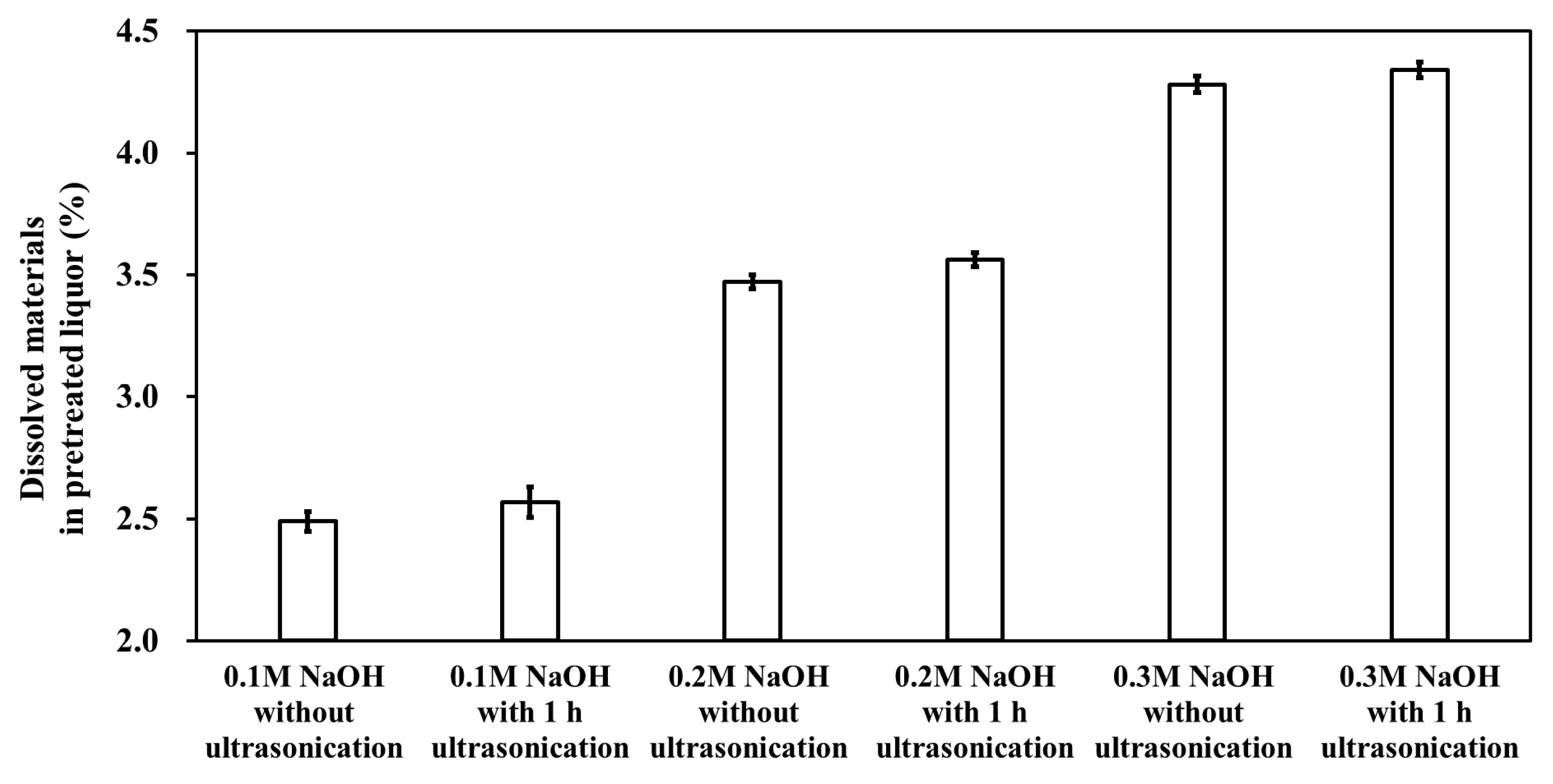
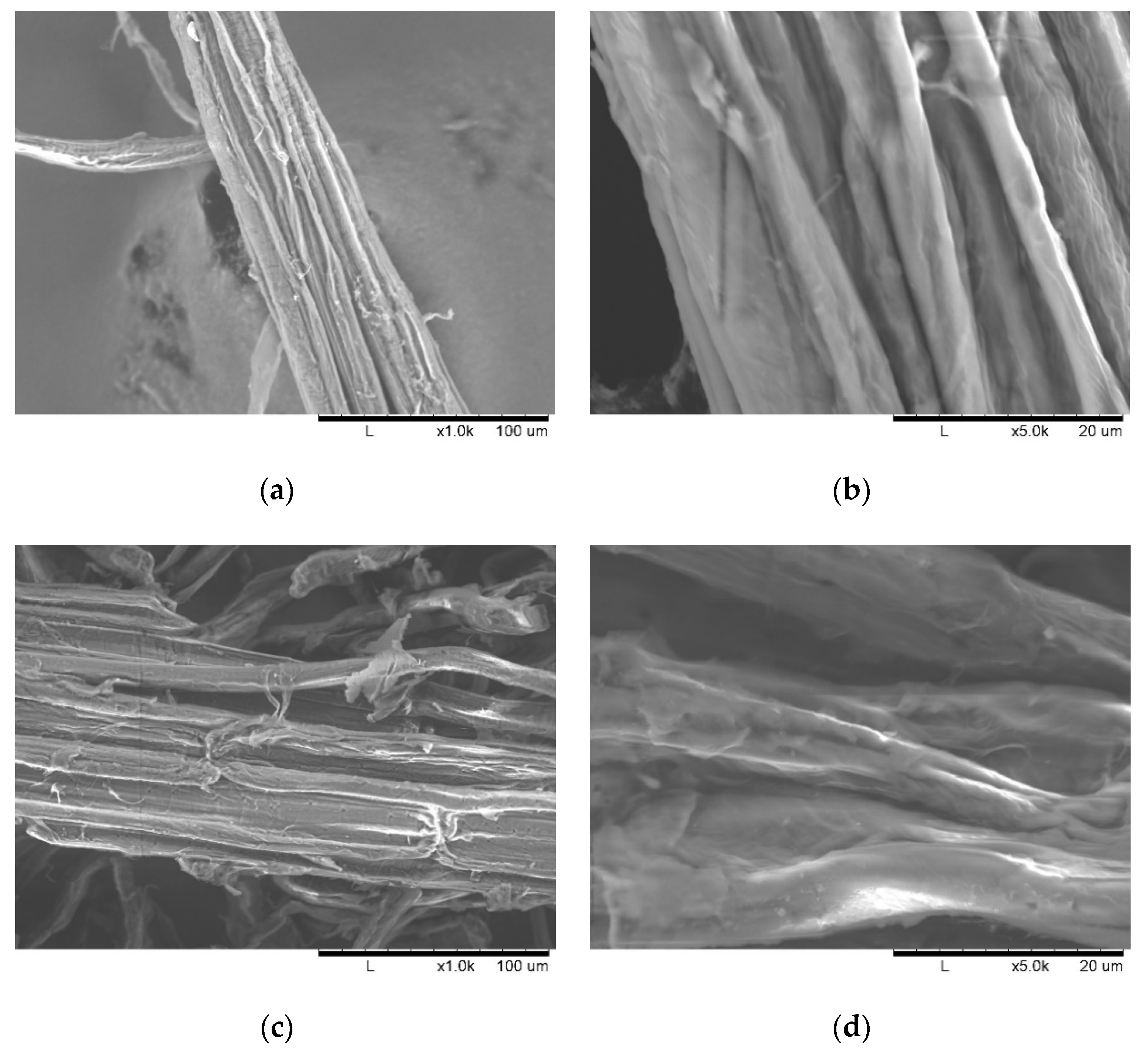
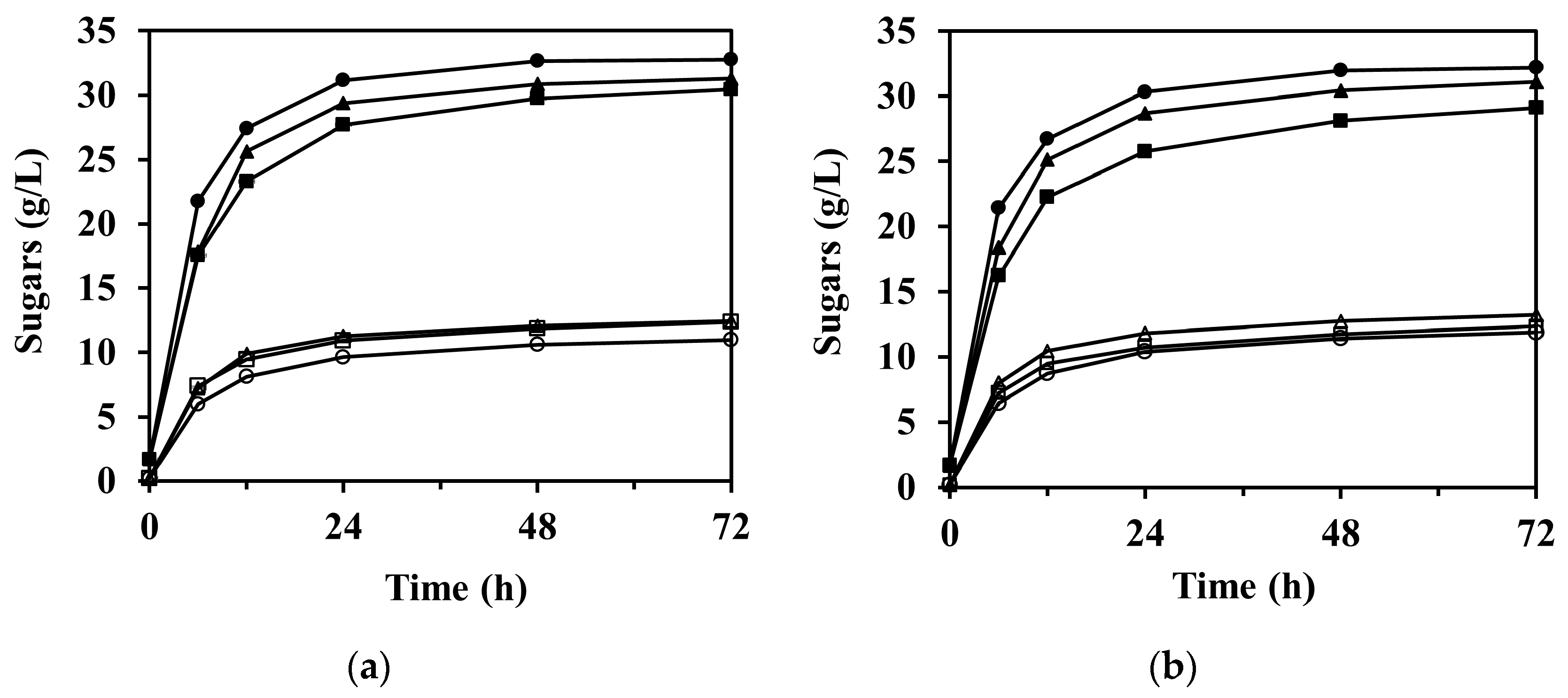
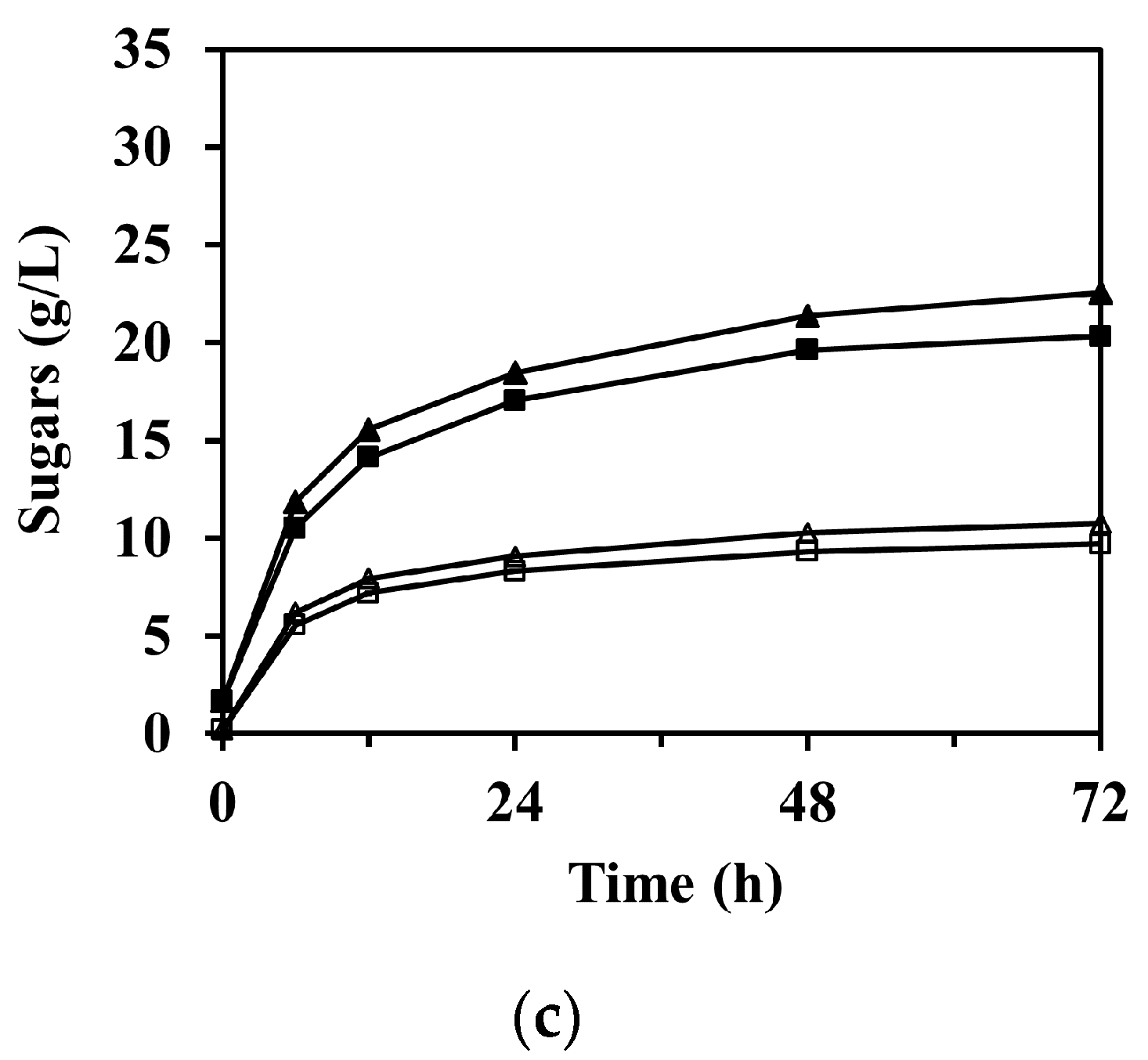
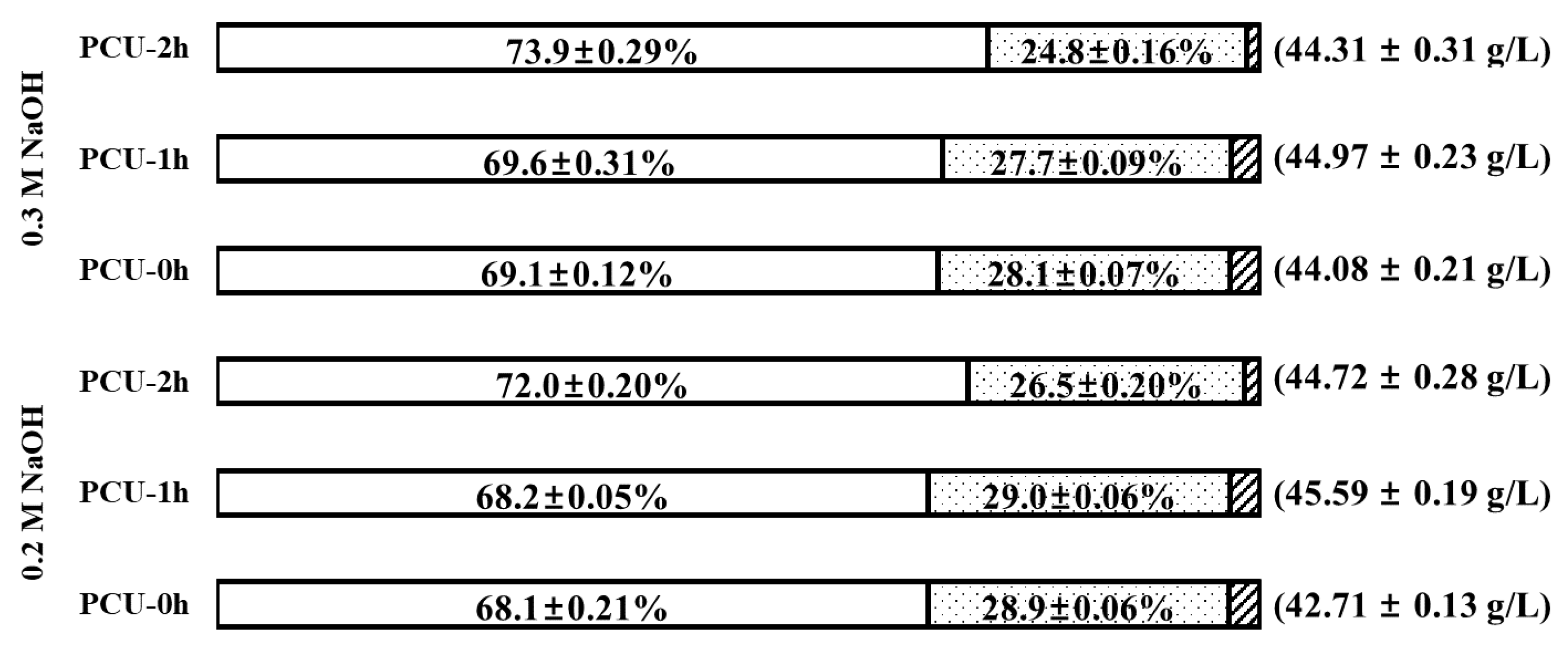
| Alkaline Usage (mol-NaOH/kg-Biomass) | Ultra-Sonication [h] | Glucan | Xylan | Arabinan | Lignin | Others | |
|---|---|---|---|---|---|---|---|
| Pre-Soaking | Pretreatment | ||||||
| 0.93 (6.0 M) | 1.13 (0.1 M) | 0 1 | 50.89 ± 0.25 51.62 ± 0.05 | 28.61 ± 0.23 28.27 ± 0.09 | 3.40 ± 0.04 3.44 ± 0.06 | 15.60 ± 0.01 15.18 ± 0.18 | 1.51 ± 0.45 1.49 ± 0.27 |
| 2.25 (0.2 M) | 0 1 2 | 57.29 ± 0.85 58.38 ± 0.20 60.22 ± 0.27 | 28.74 ± 0.19 29.68 ± 0.12 28.64 ± 0.94 | 3.58 ± 0.60 3.33 ± 0.08 3.26 ± 0.91 | 9.95 ± 0.21 8.26 ± 0.03 6.52 ± 0.10 | 0.45 ± 0.48 0.35 ± 0.20 1.36 ± 0.13 | |
| 3.38 (0.3 M) | 0 1 2 | 59.58 ± 1.03 60.11 ± 0.14 63.12 ± 0.65 | 27.50 ± 0.37 28.02 ± 0.17 27.49 ± 1.15 | 3.34 ± 0.45 3.21 ± 0.07 2.66 ± 0.74 | 8.34 ± 1.02 7.87 ± 0.09 6.31 ± 0.68 | 1.25 ± 0.70 0.80 ± 0.35 0.41 ± 0.41 | |
| Biomass M. sacchariflorus G1 | 39.61 ± 0.36 | 25.33 ± 0.28 | 3.30 ± 0.39 | 23.10 ± 0.38 | 8.66 ± 0.78 | ||
Publisher’s Note: MDPI stays neutral with regard to jurisdictional claims in published maps and institutional affiliations. |
© 2020 by the authors. Licensee MDPI, Basel, Switzerland. This article is an open access article distributed under the terms and conditions of the Creative Commons Attribution (CC BY) license (http://creativecommons.org/licenses/by/4.0/).
Share and Cite
Byun, J.; Cha, Y.-L.; Park, S.-M.; Kim, K.-S.; Lee, J.-E.; Kang, Y.-G. Lignocellulose Pretreatment Combining Continuous Alkaline Single-Screw Extrusion and Ultrasonication to Enhance Biosugar Production. Energies 2020, 13, 5636. https://doi.org/10.3390/en13215636
Byun J, Cha Y-L, Park S-M, Kim K-S, Lee J-E, Kang Y-G. Lignocellulose Pretreatment Combining Continuous Alkaline Single-Screw Extrusion and Ultrasonication to Enhance Biosugar Production. Energies. 2020; 13(21):5636. https://doi.org/10.3390/en13215636
Chicago/Turabian StyleByun, Jongwon, Young-Lok Cha, Sung-Min Park, Kwang-Soo Kim, Ji-Eun Lee, and Yong-Gu Kang. 2020. "Lignocellulose Pretreatment Combining Continuous Alkaline Single-Screw Extrusion and Ultrasonication to Enhance Biosugar Production" Energies 13, no. 21: 5636. https://doi.org/10.3390/en13215636
APA StyleByun, J., Cha, Y.-L., Park, S.-M., Kim, K.-S., Lee, J.-E., & Kang, Y.-G. (2020). Lignocellulose Pretreatment Combining Continuous Alkaline Single-Screw Extrusion and Ultrasonication to Enhance Biosugar Production. Energies, 13(21), 5636. https://doi.org/10.3390/en13215636





